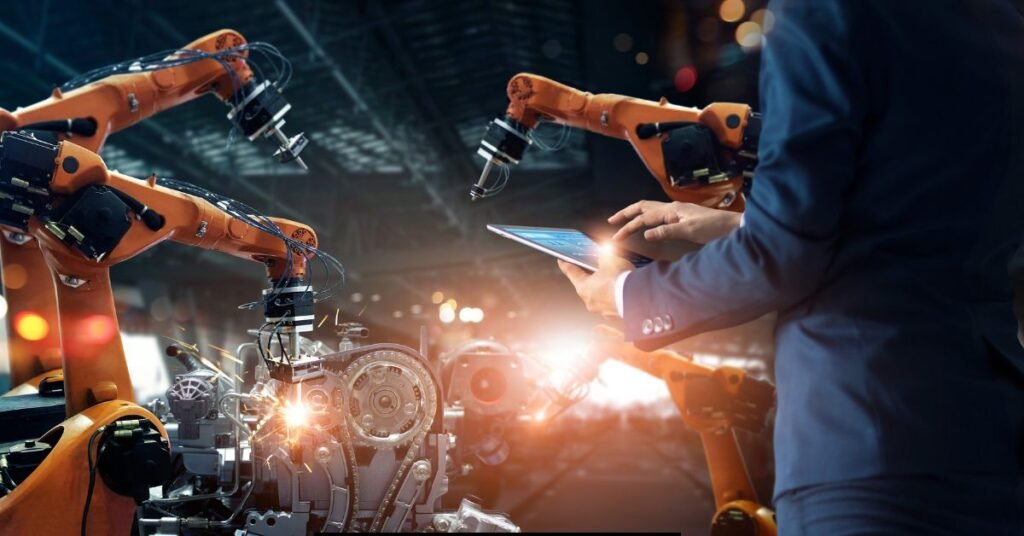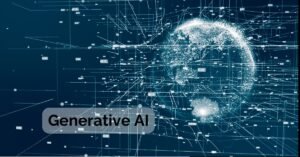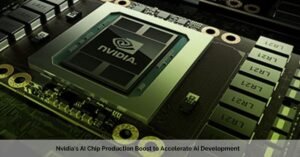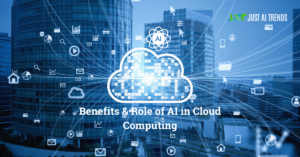The fusion of artificial intelligence (AI) and robotics is reshaping industries and our world. This powerful combination is giving rise to intelligent machines capable of performing tasks with precision, autonomy, and adaptability. Explore the relationship between AI and robotics, their key applications, challenges, and the promising future
Robotics and Artificial Intelligence
Robotics
Robotics is the branch of technology that deals with the design, construction, operation, and use of robots. Robots are machines capable of performing tasks automatically, with or without human supervision. They can range from simple industrial robots to complex humanoid robots designed to mimic human behavior.
Artificial Intelligence (AI)
AI is the simulation of human intelligence in machines that are programmed to think like humans and mimic their actions. It involves developing intelligent agents, which are systems that can perceive their environment, learn, reason, and take actions to achieve goals.
Connection Between Robotics and AI
While robotics and AI are distinct fields, they are deeply interconnected. AI provides the intelligence that enables robots to perform complex tasks, learn from experience, and adapt to new situations. Here’s how they work together:
- Perception: AI algorithms, such as computer vision, allow robots to perceive their environment through sensors like cameras and lidar.
- Decision Making: AI enables robots to process information from sensors, analyze it, and make informed decisions.
- Learning: Machine learning, a subset of AI, allows robots to learn from experience and improve their performance over time.
- Natural Language Processing: AI-powered language models enable robots to understand and respond to human language.
In essence, AI acts as the brain of a robot, allowing it to perform tasks that would be difficult or impossible for a traditional, pre-programmed robot. The combination of robotics and AI is driving innovation in various fields, including manufacturing, healthcare, transportation, and exploration.
How AI Powers Robotics
Artificial Intelligence (AI) is the driving force behind the capabilities of modern robotics.
It provides the intelligence that transforms machines from simple automatons into adaptable, intelligent systems. Here’s how AI enhances robotics:
Perception
- Computer Vision: AI enables robots to “see” the world through cameras and sensors. This allows them to identify objects, people, and environments, and make decisions based on what they perceive.
- Sensor Fusion: By combining data from multiple sensors (like lidar, radar, and cameras), AI helps robots create a comprehensive understanding of their surroundings.
Decision Making
- Machine Learning: AI algorithms analyze vast amounts of data to recognize patterns and make informed decisions. This allows robots to optimize tasks, solve problems, and adapt to changing conditions.
- Natural Language Processing: AI enables robots to understand and respond to human language, fostering communication and collaboration.
Action
- Motion Planning: AI assists robots in planning and executing complex movements, avoiding obstacles and navigating through environments efficiently.
- Control Systems: AI-driven control systems ensure precise and efficient movement, allowing robots to perform tasks with accuracy.
Learning and Adaptation
- Reinforcement Learning: AI allows robots to learn through trial and error, improving their performance over time. This enables them to adapt to new situations and challenges.
- Transfer Learning: AI enables robots to apply knowledge gained from one task to another, accelerating learning and problem-solving.
AI provides the cognitive abilities necessary for robots to perceive, understand, learn, and act intelligently in the world around them. This powerful combination is driving innovation across industries, from manufacturing and healthcare to exploration and entertainment.
Key Applications of AI in Robotics
The synergy between AI and robotics has led to a wide range of applications across various industries. Here are some key areas:
Industrial Automation
- Assembly Line Robotics: AI-powered robots can perform complex assembly tasks with precision and speed, increasing production efficiency.
- Quality Control: Robots equipped with AI-driven vision systems can inspect products for defects, ensuring high-quality output.
- Predictive Maintenance: AI helps predict equipment failures, minimizing downtime and optimizing maintenance schedules.
Healthcare
- Surgical Assistance: Robotic systems with AI capabilities assist surgeons in performing complex procedures with greater precision and minimal invasiveness.
- Drug Discovery: AI accelerates drug discovery by analyzing vast amounts of data to identify potential drug candidates.
- Elderly Care: Robots can provide companionship, assistance with daily living activities, and remote monitoring for elderly individuals.
Logistics and Warehousing
- Autonomous Mobile Robots (AMRs): AI-powered robots can navigate warehouse environments independently, transporting goods efficiently.
- Order Fulfillment: Robots can pick, pack, and ship orders accurately and quickly, improving order fulfillment times.
- Inventory Management: AI-driven robots can optimize inventory levels and storage locations.
Agriculture
- Autonomous Farming: AI-powered robots can perform tasks like planting, harvesting, and weeding, increasing agricultural productivity.
- Crop Monitoring: Robots equipped with sensors and AI can monitor crop health and detect pests or diseases early on.
- Precision Agriculture: AI helps optimize resource usage, such as water and fertilizers, for sustainable farming.
Exploration and Space
- Space Exploration: Robots with AI capabilities can explore distant planets and gather data, expanding our knowledge of the universe.
- Disaster Response: Robots can be deployed in hazardous environments to search for survivors and assist in rescue operations.
- Underwater Exploration: AI-powered underwater robots can explore ocean depths, study marine life, and collect data.
These are just a few examples of how AI is transforming robotics. As technology continues to advance, we can expect to see even more innovative and impactful applications emerge.
Challenges of AI in Robotics
While AI has significantly advanced robotics, several challenges persist:
Technical Challenges
- Perception: Accurately interpreting complex and dynamic environments remains a challenge. Factors like lighting, occlusion, and object variability can hinder perception.
- Decision Making: Making real-time decisions in uncertain and complex situations requires robust AI algorithms. Balancing speed, accuracy, and adaptability is crucial.
- Physical Interaction: Interacting with the physical world, including tasks like grasping objects or manipulating tools, is complex due to factors like force, friction, and object flexibility.
- Energy Efficiency: Balancing computational demands of AI with the need for efficient power consumption is essential for mobile robots.
Ethical and Societal Challenges
- Safety: Ensuring the safety of humans and property when interacting with robots is paramount. Preventing accidents and unintended consequences is crucial.
- Job Displacement: The increasing automation of tasks through robotics and AI raises concerns about job losses and economic impact.
- Bias: AI systems can inherit biases from the data they are trained on, leading to discriminatory outcomes. Mitigating bias is essential for fair and equitable systems.
- Privacy: Collecting and processing vast amounts of data for AI training raises privacy concerns. Protecting sensitive information is crucial.
Other Challenges
- Cost: Developing and deploying advanced AI-powered robots can be expensive, limiting their accessibility.
- Data Availability: Access to high-quality, diverse datasets is essential for training AI models. Data scarcity can hinder development.
- Explainability: Understanding the reasoning behind AI decisions is crucial for trust and accountability. Developing explainable AI models is challenging.
Addressing these challenges is essential for the continued advancement and safe deployment of AI in robotics.
Future Considerations for AI in Robotics
The future of AI in robotics holds immense promise, but it also presents significant challenges and considerations:
Technological Advancements
- Enhanced AI Capabilities: Continued advancements in machine learning, natural language processing, and computer vision will lead to more sophisticated and adaptable robots.
- Human-Robot Collaboration: Developing robots capable of seamless collaboration with humans will be a focus, leading to increased efficiency and productivity in various industries.
- Ethical AI: Ensuring that AI systems in robotics adhere to ethical principles will be crucial for public trust and acceptance.
- Edge Computing: Processing data closer to the robot will improve real-time decision-making and reduce latency.
Societal Implications
- Job Market: The integration of AI and robotics into the workforce will require careful consideration of job displacement and retraining programs.
- Privacy and Security: Protecting data privacy and ensuring the security of robotic systems will be paramount.
- Regulations: Developing appropriate regulations to govern the development and deployment of AI-powered robots will be essential.
Potential Applications
- Healthcare: Robots will play an increasingly important role in healthcare, from surgery assistance to patient care.
- Elderly Care: AI-powered robots can provide companionship, assistance with daily tasks, and remote monitoring for the elderly.
- Exploration: Robots will continue to explore hostile environments, such as space and underwater, gathering valuable data.
- Domestic Use: Household robots could become common, performing tasks like cleaning, cooking, and providing companionship.
It is essential to approach the future of AI in robotics with a balanced perspective, considering both the potential benefits and challenges. By carefully addressing these factors, we can harness the full potential of this technology while mitigating risks.
Summary of AI in Robotics
AI is the brain behind the brawn of robotics. By combining artificial intelligence with robotic systems, machines can perceive their environment, learn from experience, make decisions, and perform complex tasks autonomously.
Key areas where AI enhances robotics include:
- Perception: Using sensors and computer vision to understand the world.
- Decision making: Utilizing machine learning to analyze data and make informed choices.
- Action: Enabling robots to execute tasks with precision and efficiency through motion planning and control systems.
- Learning and adaptation: Allowing robots to improve over time through reinforcement learning and transfer learning.
Applications of AI in robotics span various industries:
- Industrial automation (assembly, quality control, maintenance)
- Healthcare (surgery, drug discovery, elderly care)
- Logistics and warehouse management (autonomous robots, inventory, order fulfillment)
- Agriculture (precision farming, harvesting, drone monitoring)
- Exploration and space (autonomous vehicles, space exploration)
- Customer service (chatbots, retail assistance)
While AI offers significant advantages, challenges such as perception accuracy, decision-making complexity, physical interaction, energy efficiency, safety, job displacement, bias, privacy, cost, data availability, and explainability need to be addressed.
The future of AI in robotics holds immense potential, with advancements in technology, human-robot collaboration, ethical AI, and edge computing. However, careful consideration of societal implications, job market changes, privacy, and regulations is essential.
Overall, AI is a catalyst for transforming robotics from mechanical devices to intelligent machines capable of revolutionizing various aspects of our lives.
Conclusion
AI empowers robots to transition from mere mechanical devices to intelligent agents capable of perceiving, learning, and adapting to their environment. This synergy has far-reaching implications across industries, from manufacturing and healthcare to exploration and daily life.
While challenges such as safety, ethics, and job displacement must be carefully considered, the potential benefits of AI-powered robotics are immense. As technology continues to evolve, we can anticipate even more sophisticated and integrated systems that will reshape our world. The future holds exciting possibilities for human-robot collaboration, increased efficiency, and innovative solutions to global challenges.
Ultimately, the successful integration of AI and robotics depends on a balanced approach that prioritizes both technological advancement and societal well-being.









